Difference between a real-time oscilloscope and a sample oscilloscope
Real-time oscilloscopes are often referred to as DSOs (Digital Storage Oscilloscopes) or MSOs (Mixed Signal Oscilloscopes). Most oscilloscopes sold today are real-time oscilloscopes. Real-time oscilloscopes are available in bandwidths ranging from a few MHz to tens of GHz, and at price points ranging from a few hundred dollars to hundreds of thousands of dollars. Sampling oscilloscopes, often referred to as DCAs (Digital Communications Analyzers), have bandwidths ranging from a few tens of GHz and are primarily used for analysing high-speed serial buses, optical devices and clock signals. As bandwidth increases, sampling and real-time oscilloscopes begin to overlap in several application areas.
The path to digitisation is essentially the same for both real-time and sampling oscilloscopes. The input signal is passed through the oscilloscope's front-end signal conditioning circuitry, digitised, saved to memory and finally displayed on the screen. However, the underlying technology of the two oscilloscopes is quite different.
Real-Time Oscilloscopes
Real-time oscilloscopes include trigger ASIC technology that allows the user to specify events of interest, such as rising voltage thresholds, build and hold violations, or code triggers. When the event is observed by the oscilloscope's trigger circuitry in regular acquisition mode, the oscilloscope will capture and save successive samples near the trigger point and update the display with the captured data. The real-time oscilloscope can operate in either single-capture mode or continuous-capture mode. In single-capture mode, the oscilloscope performs a single acquisition and displays a set of consecutive samples, depending on the memory depth and sample rate settings.
After the oscilloscope has captured a single trace, the user is able to pan and zoom to any event of interest. In continuous operation mode, the oscilloscope continuously acquires and displays each condition that matches the trigger specifications. Variable or infinite afterglow allows multiple captured signals to be overlaid on the initial signal. Continuous mode allows the user to have a real-time view of the device under test. Rise time or pulse width measurements, mathematical functions, or FFT analyses can be performed in single acquisition or continuous repeat acquisition modes. Most real-time oscilloscopes with bandwidths below 6 GHz include lMΩ and 50 MΩ inputs and can be used with a wide range of probes and cables.
There are three important technical specifications that define a real-time oscilloscope: bandwidth, sample rate, and memory depth. There are other, more important specifications to consider when selecting a real-time oscilloscope.
Sampling oscilloscopes are designed to capture, display and analyse repetitive signals. The trigger capability is also set for repetitive signals. When the first trigger condition is met, the Sampling Oscilloscope will capture a set of non-neighbouring samples with a time interval. The oscilloscope delays this trigger point and starts the next set of captures, placing the captured points in the display with the first set of samples. Repeating this operation in infinite afterglow mode creates a waveform that does not have to be acquired continuously. Trigger and delay are among the technical elements used to control the time resolution between triggers to achieve high measurement accuracy. Since only a few points are captured and processed per trigger, memory depth is not a key technical specification. The sampling rate is also not a key specification. However, it is the accuracy of the time interval between the first trigger condition and the next trigger condition that is most important.
Sampling Oscilloscopes and Real-Time Oscilloscopes
As mentioned earlier, real-time oscilloscopes now have bandwidths in excess of 60 GHz, while sampling oscilloscopes have bandwidths in excess of 90 GHz. Thus, for most digital applications, bandwidth is no longer a convenient way to select the appropriate oscilloscope. That said, price is still the main difference. Fully configured sampling oscilloscopes (50 GHz) cost less than $150,000, while real-time oscilloscopes cost close to $400,000. Designers must determine if the excellent flexibility of real-time oscilloscopes is commensurate with the high cost.






